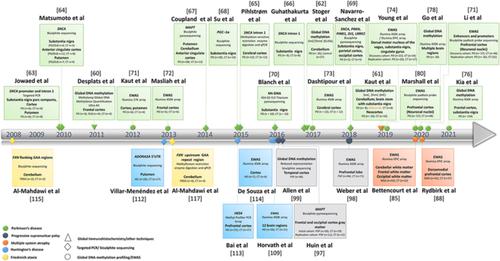当前位置:
X-MOL 学术
›
Neuropathol. Appl. Neurobiol.
›
论文详情
Our official English website, www.x-mol.net, welcomes your
feedback! (Note: you will need to create a separate account there.)
Neurodegenerative movement disorders: An epigenetics perspective and promise for the future
Neuropathology and Applied Neurobiology ( IF 4.0 ) Pub Date : 2021-07-27 , DOI: 10.1111/nan.12757 Megha Murthy 1, 2 , Yun Yung Cheng 1 , Janice L Holton 1, 2 , Conceição Bettencourt 1, 3
Neuropathology and Applied Neurobiology ( IF 4.0 ) Pub Date : 2021-07-27 , DOI: 10.1111/nan.12757 Megha Murthy 1, 2 , Yun Yung Cheng 1 , Janice L Holton 1, 2 , Conceição Bettencourt 1, 3
Affiliation

|
Neurodegenerative movement disorders (NMDs) are age-dependent disorders that are characterised by the degeneration and loss of neurons, typically accompanied by pathological accumulation of different protein aggregates in the brain, which lead to motor symptoms. NMDs include Parkinson's disease, multiple system atrophy, progressive supranuclear palsy, and Huntington's disease, among others. Epigenetic modifications are responsible for functional gene regulation during development, adult life and ageing and have progressively been implicated in complex diseases such as cancer and more recently in neurodegenerative diseases, such as NMDs. DNA methylation is by far the most widely studied epigenetic modification and consists of the reversible addition of a methyl group to the DNA without changing the DNA sequence. Although this research field is still in its infancy in relation to NMDs, an increasing number of studies point towards a role for DNA methylation in disease processes. This review addresses recent advances in epigenetic and epigenomic research in NMDs, with a focus on human brain DNA methylation studies. We discuss the current understanding of the DNA methylation changes underlying these disorders, the potential for use of these DNA modifications in peripheral tissues as biomarkers in early disease detection, classification and progression as well as a promising role in future disease management and therapy.
中文翻译:

神经退行性运动障碍:表观遗传学观点和未来前景
神经退行性运动障碍 (NMDs) 是一种与年龄相关的疾病,其特征是神经元的退化和丧失,通常伴随着大脑中不同蛋白质聚集体的病理性积累,从而导致运动症状。NMD 包括帕金森病、多系统萎缩、进行性核上性麻痹和亨廷顿病等。表观遗传修饰负责发育、成年和衰老过程中的功能基因调控,并逐渐与癌症等复杂疾病以及最近的神经退行性疾病(例如 NMD)有关。DNA 甲基化是迄今为止研究最广泛的表观遗传修饰,它包括在不改变 DNA 序列的情况下将甲基可逆地添加到 DNA 中。尽管这一研究领域在 NMD 方面仍处于起步阶段,但越来越多的研究指出 DNA 甲基化在疾病过程中的作用。这篇综述讨论了 NMD 表观遗传学和表观基因组研究的最新进展,重点是人脑 DNA 甲基化研究。我们讨论了目前对这些疾病背后的 DNA 甲基化变化的理解,这些 DNA 修饰在外周组织中用作早期疾病检测、分类和进展的生物标志物的潜力,以及在未来疾病管理和治疗中的有希望的作用。专注于人脑 DNA 甲基化研究。我们讨论了目前对这些疾病背后的 DNA 甲基化变化的理解,这些 DNA 修饰在外周组织中用作早期疾病检测、分类和进展的生物标志物的潜力,以及在未来疾病管理和治疗中的有希望的作用。专注于人脑 DNA 甲基化研究。我们讨论了目前对这些疾病背后的 DNA 甲基化变化的理解,这些 DNA 修饰在外周组织中用作早期疾病检测、分类和进展的生物标志物的潜力,以及在未来疾病管理和治疗中的有希望的作用。
更新日期:2021-07-27
中文翻译:

神经退行性运动障碍:表观遗传学观点和未来前景
神经退行性运动障碍 (NMDs) 是一种与年龄相关的疾病,其特征是神经元的退化和丧失,通常伴随着大脑中不同蛋白质聚集体的病理性积累,从而导致运动症状。NMD 包括帕金森病、多系统萎缩、进行性核上性麻痹和亨廷顿病等。表观遗传修饰负责发育、成年和衰老过程中的功能基因调控,并逐渐与癌症等复杂疾病以及最近的神经退行性疾病(例如 NMD)有关。DNA 甲基化是迄今为止研究最广泛的表观遗传修饰,它包括在不改变 DNA 序列的情况下将甲基可逆地添加到 DNA 中。尽管这一研究领域在 NMD 方面仍处于起步阶段,但越来越多的研究指出 DNA 甲基化在疾病过程中的作用。这篇综述讨论了 NMD 表观遗传学和表观基因组研究的最新进展,重点是人脑 DNA 甲基化研究。我们讨论了目前对这些疾病背后的 DNA 甲基化变化的理解,这些 DNA 修饰在外周组织中用作早期疾病检测、分类和进展的生物标志物的潜力,以及在未来疾病管理和治疗中的有希望的作用。专注于人脑 DNA 甲基化研究。我们讨论了目前对这些疾病背后的 DNA 甲基化变化的理解,这些 DNA 修饰在外周组织中用作早期疾病检测、分类和进展的生物标志物的潜力,以及在未来疾病管理和治疗中的有希望的作用。专注于人脑 DNA 甲基化研究。我们讨论了目前对这些疾病背后的 DNA 甲基化变化的理解,这些 DNA 修饰在外周组织中用作早期疾病检测、分类和进展的生物标志物的潜力,以及在未来疾病管理和治疗中的有希望的作用。











































 京公网安备 11010802027423号
京公网安备 11010802027423号